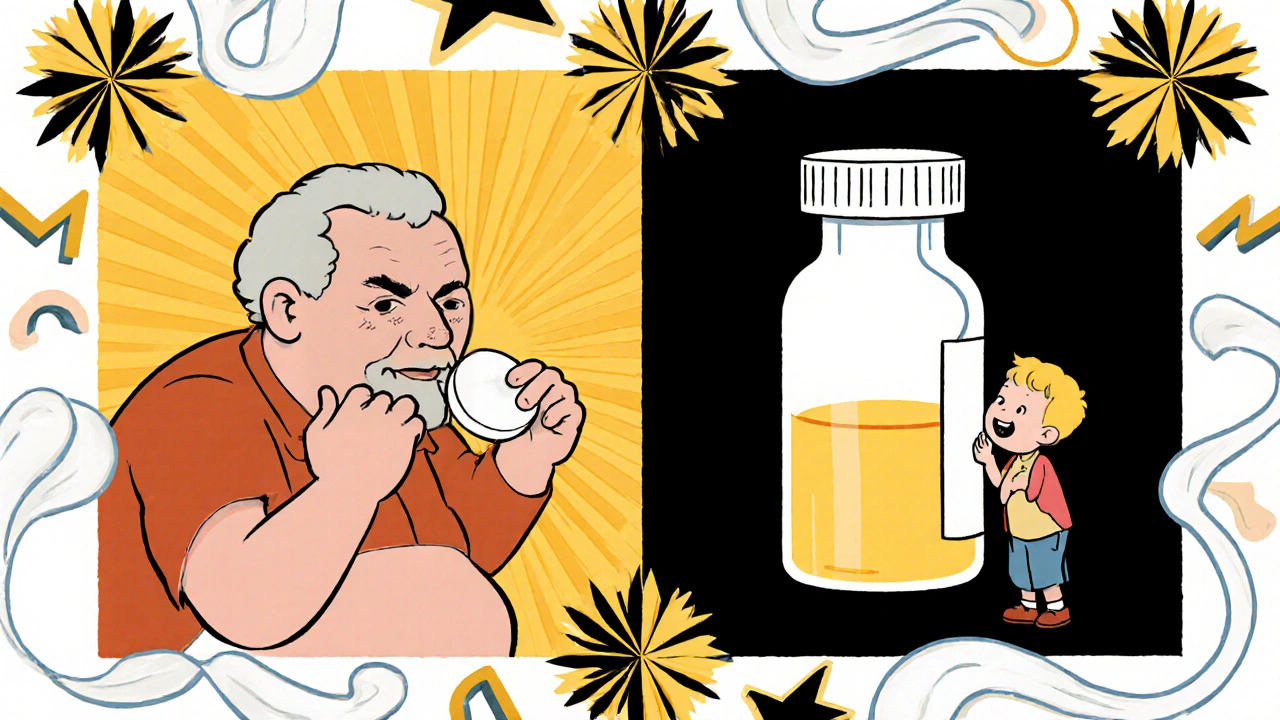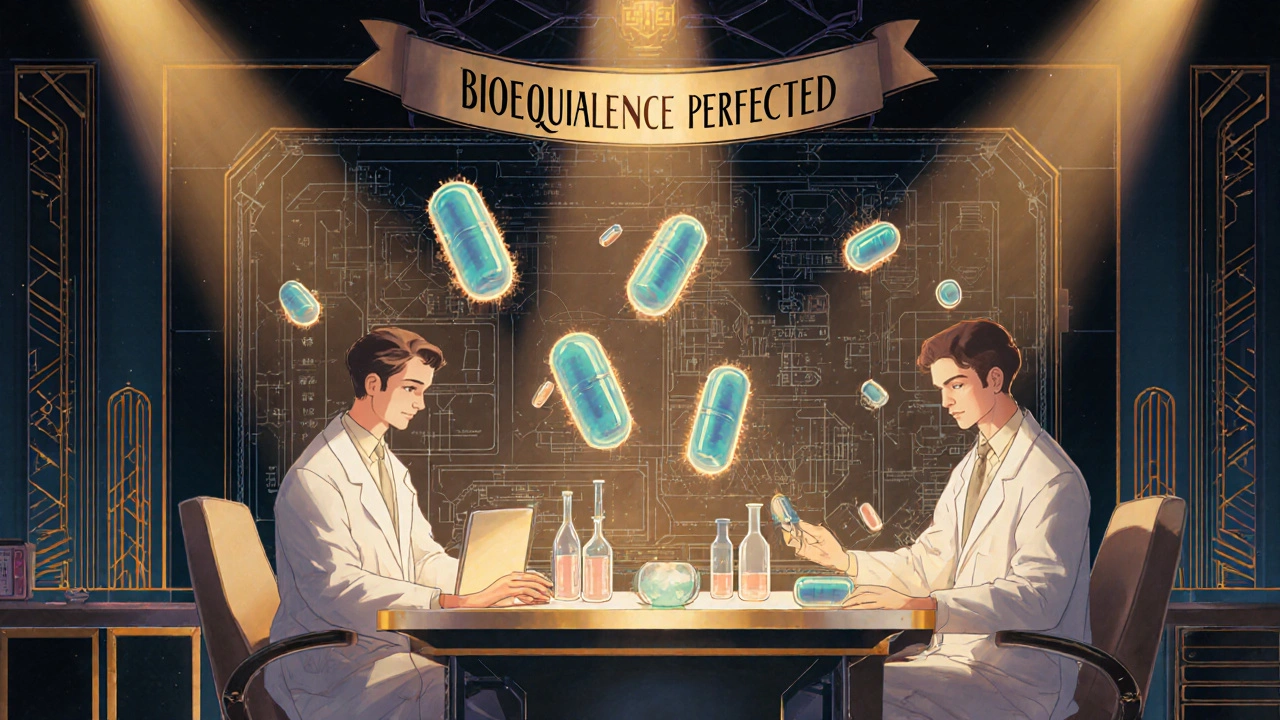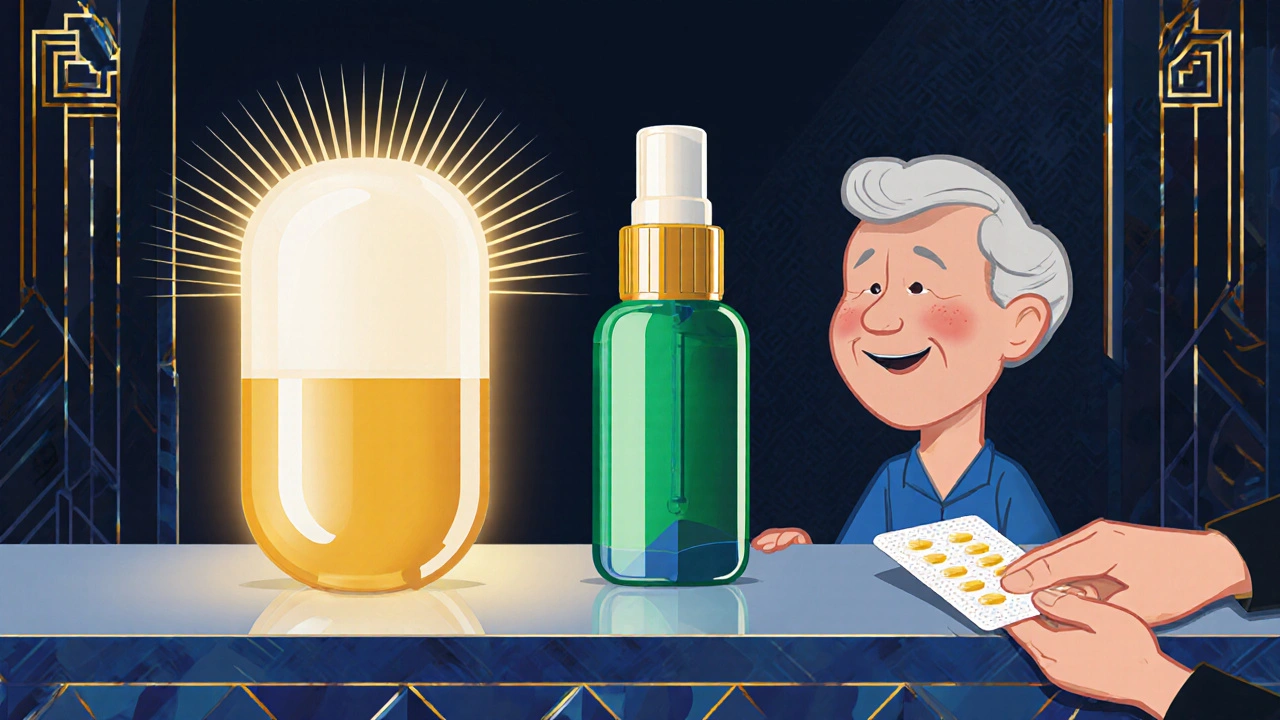Have you ever picked up your prescription and noticed the pill looks different? Maybe it’s a different color, shape, or even comes as a liquid instead of a tablet. You might wonder: is this the same medicine? The answer is usually yes-but the way it’s made has changed. This isn’t a mistake. It’s called medication reformulation, and it’s happening more than you think.
What Exactly Is a Reformulation?
Reformulation means changing how a drug is made-without changing the active ingredient. Think of it like upgrading a car engine. The fuel (the active drug) stays the same, but now it burns cleaner, smoother, or lasts longer. Companies might alter the tablet’s coating to make it dissolve slower, switch from a pill to a patch, or remove an ingredient that causes stomach upset. The goal? Better patient experience, fewer side effects, or easier dosing.The FDA has a special pathway for this, called 505(b)(2). It lets drugmakers use existing safety data from the original version instead of starting from scratch. That’s why reformulations get approved faster and cheaper. A brand-new drug can cost $2.6 billion and take 15 years to develop. A reformulation? Often under $100 million and under five years.
Why Do Companies Do This?
It’s not just about profits. While some critics call it “evergreening”-making tiny changes just to extend patents-many reformulations are genuinely helpful. Take an elderly patient with arthritis who struggles to swallow pills. A reformulated version that comes as a dissolving strip or a liquid can make all the difference. Or someone with diabetes who needs to take insulin multiple times a day. A reformulated long-acting version might cut that down to once daily.Orphan drugs-medicines for rare diseases-are especially ripe for reformulation. There aren’t many patients, so companies need to make the drug as easy to use as possible. One case study from Kymanox showed a mid-sized company turning an injectable orphan drug into an oral tablet. The result? Patients were far more likely to stick with the treatment. Compliance jumped. Hospital visits dropped. That’s not just business-it’s better health.
How Are Reformulations Made?
It’s not as simple as swapping ingredients. Every change must be tested to prove the new version works the same way in the body. That’s called bioequivalence. If a pill is changed to a capsule, does it still release the drug at the same rate? If the coating is removed, does it dissolve too fast and cause nausea? These questions are answered with rigorous testing.Here are the most common types of reformulations:
- Changing the release pattern: From immediate-release to extended-release (like a 12-hour or 24-hour pill).
- Switching the delivery method: Oral tablet to nasal spray, patch, or inhaler.
- Adjusting excipients: Removing dyes, gluten, or lactose for people with allergies or sensitivities.
- Improving stability: Making the drug last longer on the shelf without refrigeration.
- Combining drugs: Merging two separate pills into one to simplify regimens.
Each change requires new manufacturing processes, new quality controls, and new regulatory filings. It’s not a quick fix. It takes 12 to 24 months of work, with teams of chemists, pharmacists, and regulatory experts all collaborating. One misstep-and the whole thing gets delayed or rejected.

Are Reformulated Drugs Safe?
Yes, when done right. The FDA requires reformulated drugs to prove they deliver the same amount of medicine into the bloodstream at the same rate as the original. That’s bioequivalence. If the drug is meant to be absorbed slowly over 12 hours, the reformulated version must do the same.But there are exceptions. If a reformulation changes how the drug works-say, turning a blood pressure pill into one that also lowers cholesterol-it’s treated like a new drug. Full clinical trials are needed. That’s rare. Most reformulations are subtle, focused on how the drug is delivered, not what it does.
Still, problems happen. Sometimes, a reformulation introduces a new side effect. A patient might report dizziness after switching to a new brand. That’s not always because the drug is unsafe-it could be a change in how fast the body absorbs it. Doctors and pharmacists need to watch for these shifts.
What’s the Impact on Patients?
For many, reformulations are life-changing. A child with epilepsy who used to need injections three times a day now takes a once-daily syrup. A cancer patient with mouth sores can’t swallow pills-so a liquid version lets them keep treatment going. A busy parent forgets pills but remembers patches. These aren’t small wins. They’re the difference between managing a condition and being controlled by it.But confusion is common. Patients often think a different-looking pill means a different drug. They might stop taking it, or worry it’s fake. Pharmacists play a key role here. When a prescription switches to a reformulated version, the pharmacist should explain the change. Not every pharmacy does this-but they should.

Why Reformulation Beats New Drug Development
Developing a brand-new drug is like building a house from the ground up. You need to find the right materials, design the blueprint, get permits, and hope no one else builds the same thing first. Reformulation? It’s like renovating an existing house. You keep the foundation, but upgrade the plumbing, add solar panels, and repaint.Here’s the numbers: Only about 10% of new drugs make it to market. For reformulations? Around 30%. That’s three times the success rate. And it’s not just about cost. It’s speed. A reformulation can go from idea to pharmacy shelf in under two years. A new drug? More than a decade.
That’s why big pharma and small startups alike are investing here. It’s smarter. It’s faster. And it helps real people right now.
The Future of Reformulation
New technologies are making reformulation even more powerful. Think nanoparticles that target drugs directly to inflamed joints. Or smart patches that release medicine based on your body’s needs. Researchers are even working on 3D-printed pills that can combine multiple drugs in one dose, customized for your exact needs.The FDA is keeping pace. In 2022, they released new guidance to make it easier to approve new dosage forms for existing drugs. That means more options are coming-especially for children, seniors, and people with complex conditions.
Reformulation isn’t the future of medicine. It’s already here. And it’s quietly improving millions of lives-one changed pill at a time.
Are reformulated drugs the same as generics?
No. Generics are exact copies of the original drug, made after the patent expires. Reformulations are modified versions, often made by the original company while the patent is still active. Generics must match the original in every way. Reformulations change something-like how it’s taken or how fast it works-but still prove it works the same in the body.
Can reformulation make a drug less effective?
It’s possible, but rare. Regulators require reformulated drugs to prove they’re bioequivalent to the original. If a patient notices a change in how they feel-like more side effects or less relief-they should talk to their doctor. Sometimes, a new formulation just takes time to adjust to. Other times, it might not be the right fit.
Why do pharmacies switch to reformulated versions without telling me?
Pharmacies often switch based on cost or availability. A reformulated version might be cheaper for the insurer, or easier to stock. But they’re not always required to notify you. That’s why it’s important to check your pills each time you refill. If it looks different, ask the pharmacist: "Is this the same medicine? Has it changed?"
Do reformulations cost more than the original?
Sometimes. If the reformulation is still under patent, the price might be higher. But once generics enter the market, prices usually drop. Even if the reformulation is more expensive, it might save money long-term by reducing hospital visits or missed doses. Insurance plans often cover reformulated versions if they’re deemed medically appropriate.
Can I ask my doctor to prescribe the original version?
Yes. You can ask your doctor to write "Do Not Substitute" on your prescription. This tells the pharmacy to fill it exactly as written. But keep in mind: if the original is discontinued, you may not have a choice. Also, if the reformulation is better for you-like easier to swallow or fewer side effects-it might be worth trying.
What Should You Do?
If you take any regular medication, pay attention. Don’t assume a new-looking pill is the same. Check the name, dose, and shape. Ask your pharmacist: "Has this changed?" If you notice new side effects or if the medicine doesn’t seem to work as well, tell your doctor. Your experience matters.Reformulation isn’t magic. It’s science. And when done right, it’s one of the quietest, most effective ways medicine gets better-for everyone.

This is just pharma playing games. They don't care if you can swallow it-they care if you keep paying for it. I switched to a new version of my blood pressure med and got dizzy for a week. No one warned me. Now I'm stuck with it because the old one's 'discontinued.' Classic corporate move. 🤡
reformulation? more like re-marketing. they just wanna keep the patent alive so they can charge 500 bucks for a pill that cost 2 cents to make. i dont care if its 'bioequivalent'-if it looks different and feels different, its different. my body knows.
OMG I just realized my grandma’s arthritis pill changed shape last month and she thought it was fake and stopped taking it for TWO WEEKS 😭 She’s 78 and lives on a fixed income-she doesn’t have time to Google bioequivalence. Pharmacies need to TELL PEOPLE when this stuff changes. Like, right when they hand over the bottle. 🙏
This whole article reads like a pharma press release. 'Quietly improving millions of lives'? Please. Reformulations are a loophole. A legal tax dodge for lazy corporations who don't want to innovate-they just want to keep cashing in. The FDA lets them skate by with half the testing. This isn't progress. It's exploitation dressed up as science. 🤮
I work with elderly patients daily. One man with Parkinson’s couldn’t swallow pills anymore-his wife cried because he was skipping doses. Then we switched him to a liquid reformulation. He started taking it again. He smiled again. This isn’t just chemistry-it’s dignity. Don’t dismiss this because it’s not a 'new drug.' Sometimes the most powerful medicine is the one you actually take.
And yes, pharmacists should explain changes. But they’re overworked. We need systems-not just goodwill-to make sure patients aren’t left in the dark.
So let me get this straight-companies are allowed to tweak a pill, skip 90% of clinical trials, and still call it 'the same'? 🤡 And you’re acting like this is a win for patients? I’ve seen people have seizures after a reformulation. The FDA doesn't track adverse events well enough. This isn't innovation. It's a minefield with a green light. 🚨
The structural inertia of pharmaceutical regulation favors incrementalism over disruption. Reformulation, from a systems perspective, represents an adaptive optimization within existing regulatory affordances. It reduces entropy in the drug development lifecycle-lowering transaction costs, accelerating access, and improving adherence metrics among marginalized populations. Yet, the epistemic asymmetry between manufacturer narratives and patient experience remains unaddressed. We need participatory transparency protocols-not just bioequivalence thresholds.
My pill changed color again 😅 I just shrugged and took it. If it still works, who cares? 🤷♀️💊